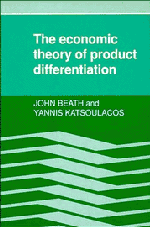Book contents
- Frontmatter
- Contents
- Preface
- 1 Introduction
- 2 Spatial models of imperfect competition
- 3 Symmetric preferences, the Chamberlinian paradigm
- 4 Product diversity and product selection: market equilibria and social optima
- 5 Product quality and market structure
- 6 Vertical product differentiation
- 7 Product differentiation and market imperfection: limit theorems
- 8 Product differentiation and the entry process
- 9 The gains from trade under product differentiation
- Notes
- Bibliography
- Indexes
8 - Product differentiation and the entry process
Published online by Cambridge University Press: 03 May 2010
- Frontmatter
- Contents
- Preface
- 1 Introduction
- 2 Spatial models of imperfect competition
- 3 Symmetric preferences, the Chamberlinian paradigm
- 4 Product diversity and product selection: market equilibria and social optima
- 5 Product quality and market structure
- 6 Vertical product differentiation
- 7 Product differentiation and market imperfection: limit theorems
- 8 Product differentiation and the entry process
- 9 The gains from trade under product differentiation
- Notes
- Bibliography
- Indexes
Summary
Introduction
In this chapter we focus once again on the Hotelling-type of spatial model and use it to consider some predictions about the effects of product differentiation. We shall deal with two aspects thought to be characteristic of differentiated product markets. The first of these is the question of whether or not there exist pure profits in a free-entry equilibrium. The second is the question of whether or not it is optimal to use the introduction of new products (brand proliferation) as an entry-deterring device. These are issues that have been examined by a number of authors: Archibald and Rosenbluth (1975), Bonnano (1987), Eaton and Lipsey (1976, 1978, 1980), Hay (1976), Judd (1985), Lane (1980) and Schmalensee (1978).
The existence of pure profit in free-entry equilibrium
To motivate the discussion in this section let us start by considering a market, entry into which involves the non-recoverable (sunk) cost of F. Suppose also that in the oligopoly equilibrium each firm in the market earns a profit of π(n), where n is the number of firms in the market. (Since a firm is free to close down, π(n)>0, for all n.) Now assume that π(n) decreases with n (as would be the case in standard Cournot-type oligopoly models).
- Type
- Chapter
- Information
- The Economic Theory of Product Differentiation , pp. 160 - 172Publisher: Cambridge University PressPrint publication year: 1991



